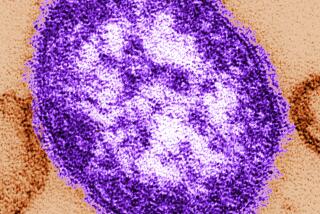Cases of German Measles Increase Sharply Over Last Year
Cases of rubella--a mild respiratory illness and skin rash that can cause devastating birth defects if contracted during the early stages of pregnancy--have increased markedly in California this year.
By the end of October, 521 cases of rubella, which is also known as German measles, had been reported to state health officials, compared to 160 in all of 1989. In Los Angeles County, 68 rubella cases had been reported by the end of September, compared to 53 cases in all of 1989.
In addition, cases of congenital rubella “are way, way more than we have had in years,” according to Dr. Shirley L. Fannin of the Los Angeles County Department of Health Services.
Nine babies from Los Angeles County and one each in San Diego and Ventura counties have been born this year with severe rubella-related birth defects, Fannin said. “It is a tragedy for families.”
Fannin said rubella-related birth defects are “95% to 97% preventable” with immunization. Women who have already had the disease are also immune.
Earlier this month, county health officials sent letters to pediatricians and hospital delivery rooms, warning them to be on the lookout for characteristics of congenital rubella syndrome, such as cataracts, small heads, heart disorders, deafness and mental retardation.
New cases of rubella have waned in recent months, with just six cases reported in all of California in September. But public health officials said this may be only a seasonal drop and that rubella cases may increase this winter.
The increase in rubella cases has also been dwarfed by the statewide measles epidemic. As of the end of October, California had registered an estimated 12,000 measles cases and 52 reported measles-related deaths. In Los Angeles County, there had been 3,062 confirmed measles cases and 17 deaths.
The measles epidemic appears to be coming under control, according to state health officials. In September, the number of new measles cases was 110, compared to the more than 2,000 cases that were reported in March.
The rubella outbreak has been “most intense” in Stanislaus County, Southern California, the San Francisco Bay Area and the Central Valley, said Dr. Loring Dales, chief of the immunization unit at the California Department of Health Services.
Orange County’s cases are running more than “five times ahead of last year’s,” said Dr. Hildy Meyers, epidemiologist for the Orange County Health Care Agency. Through September, doctors reported 73 rubella cases compared with only 11 last year.
Rubella is usually a mild disease that lasts several days. It is characterized by painful lymph nodes, a rash that lasts one to three days, and joint pains. The joint pains may persist or return.
But mothers who contract the disease during pregnancy pass it on to their developing babies, with grim consequences.
It is generally recommended that all women of child-bearing age who are not already immune to rubella be vaccinated before becoming pregnant. Applicants for marriage licenses in California are required to be tested for rubella immunity.
More to Read
Sign up for Essential California
The most important California stories and recommendations in your inbox every morning.
You may occasionally receive promotional content from the Los Angeles Times.










